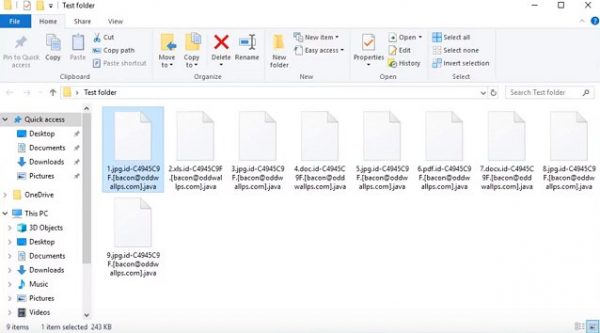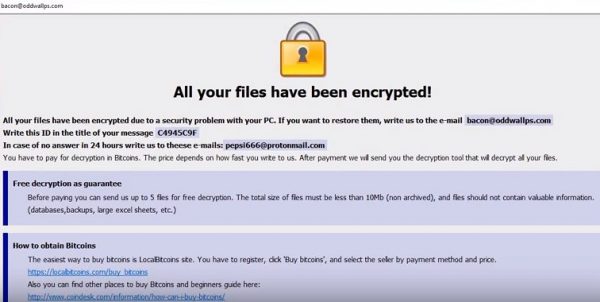.java File Virus – Dharma Ransomware imposes encryption on certain files it can reach upon installing its components into a target device. Dharma ransomware, once designating a specific threat, now rather indicates a somewhat generic name for the viruses developed from the same prototype. Java virus, accordingly, is one of such specific implementations of Dharma Ransomware.

.java Virus owes its name to adding the .java extension to the names of the files it hits. It also tends to add email address at the end of the files corrupted. The outcome corresponds to the following pattern:
[filename].[email_address].java.For instance, the user nicknamed neco423reported the following file transformation, obviously due to the ransomware invasion: filename.id-406B4F5A.[[email protected]].java.
The .java Virus – Dharma Ransomware is readily available from darknet or illegal online communities. Still, even if one manages to get a copy of the trojan to distribute it as an affiliate, there is no such tie with the master crook that would expose the latter’s identity.

Easy access to the infection makes it available for all sorts of criminals. However, the infection vectors do not seem to vary greatly as might be expected. It tends to stick to a mere spamming. A victim usually receives a letter asking to open the attachment. The opening triggers the ransomware download and installation followed by the malicious encryption. The encryption itself is really strong enough, so trying any plain approaches like brute-forcing would rather waste your time. The implementation might offer some flaws, and for certain versions of Dharma Ransomware master decryptor key or attack-specific keys are actually available thanks to the intervention of malware hunters.
The .java Virus informs its victims of its demands and the kind of attack ongoing with its ransom note. Obviously, the user also can contact the crooks via email. The follow-up is always the same and simply urges the users concerned to transfer a certain amount of bitcoins to the wallets of the crooks. To say the least, there are no guarantees while the amounts claimed could be really in excess of the user financial means and value of the information endangered.
Free guidance and tools for removal of the encryption caused by .java Virus – Dharma Ransomware follow.
Automatic removal of Java File Virus
The benefits of using the automatic security suite to get rid of this infection are obvious: it scans the entire system and detects all potential fragments of the virus, so you are a few mouse clicks away from a complete fix.
- Download and install recommended malware security suite
- Select Start Computer Scan feature and wait until the utility comes up with the scan report. Proceed by clicking on the Fix Threats button, which will trigger a thorough removal process to address all the malware issues compromising your computer and your privacy.
Restore files locked by Java File Virus
new Locky variant aka Java File Virus represents a unique category of malicious software whose attack surface reaches beyond the operating system and its components, which is why removing the virus itself is a part of the fix only. As it has been mentioned, it encrypts one’s personal information, so the next phase of the overall remediation presupposes reinstating the files that will otherwise remain inaccessible.
-
-
Launch data recovery software
Similarly to the rest of its fellow-infections, Java File Virus most likely follows an operational algorithm where it erases the original versions of the victim’s files and actually encrypts their copies. This peculiarity might make your day, because forensics-focused applications like Data Recovery Pro are capable of restoring the information that has been removed. As the virus further evolves, its modus operandi may be altered – in the meanwhile, go ahead and try this.
-
-
Take advantage of Volume Shadow Copy Service
This technique is based on using the native backup functionality that’s shipped with Windows operating system. Also referred to as Volume Snapshot Service (VSS), this feature makes regular backups of the user’s files and keeps their most recent versions as long as System Restore is on. Java File Virus ransomware hasn’t been found to affect these copies therefore the restoration vector in question is strongly recommended. The two sub-sections below highlight the automatic and manual workflow.
- a) Use Shadow ExplorerShadow Explorer is an applet that provides an easy way of retrieving previous versions of files and folders. Its pro’s include an intuitive interface where the computer’s entire file hierarchy is displayed within one window. Just pick the hard disk volume, select the object or directory to be restored, right-click on it and choose Export. Follow the app’s prompts to get the job done.

- b) Use file propertiesEssentially, what the above-mentioned Shadow Explorer tool does is it automates the process that can otherwise be performed manually via the Properties dialog for individual files. This particular approach is more cumbrous but just as effective as its software-based counterpart, so you can proceed by right-clicking on a specific file, which has been encrypted by Java File Virus, and selecting Properties in the context menu. The tab named Previous Versions is the next thing to click – it displays available versions of the file by date of the snapshot creation. Pick the latest copy and complete the retrieval by following the prompts.

-
Data backups work wonders
Ransomware like Java File Virus isn’t nearly as almighty and destructive in case you run regular file backups to the cloud or external data media. The virus itself can be completely removed in a matter of minutes, and the distorted information can then be just as easily recovered from the backup. Luckily, this is a growing trend, so ransom Trojans are hopefully going to become less subversive in the near future.
Verify thoroughness of the removal
Having carried out the instructions above, add a finishing touch to the security procedure by running an additional computer scan to check for residual malware activity
